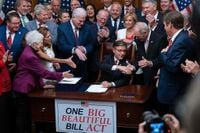President Donald Trump’s signature legislation, the One Big Beautiful Bill Act, has set off a tidal wave of changes across the United States, reshaping everything from federal tax policy to the funding of rural hospitals. Signed into law in July 2025, the bill is already being described by the Tax Foundation as "the most significant legislative change to federal tax policy since the 2017 Tax Cuts and Jobs Act." But as Americans look ahead to the coming years, the true impact of the law is just beginning to unfold—and it’s proving to be a mixed bag, depending on where you live and what services you rely on.
For residents of high-tax states like New York, the bill’s most immediate headline is the dramatic increase in the state and local tax deduction, or SALT. According to a USA TODAY report, the cap on this deduction will rise from $10,000 to $40,000 for 2025, a move that is expected to save New Yorkers almost $4,000 in 2026 alone. The Tax Foundation’s analysis projects the average tax cut for New Yorkers at $3,933 in 2026, with the largest cuts found in counties like New York ($10,562), Westchester ($6,642), and Nassau ($4,921).
Rep. Mike Lawler, R-N.Y., who led the push for the higher cap, noted that the SALT deduction had been a fixture of the U.S. tax code for over a century before it was capped at $10,000 by Trump’s 2017 tax law. "This was in effect for over 100 years prior to the 2017 passage of the Tax Cuts and Jobs Act," Lawler said, highlighting the significance of its restoration. The deduction, which covers state and local income taxes as well as property taxes, is particularly valuable for homeowners in high-cost areas. In 2022, the average SALT deduction approached $10,000 in states like Connecticut, New York, New Jersey, California, and Massachusetts, according to a Bipartisan Policy Center analysis.
But the benefits aren’t limited to the very wealthy. While a 2021 Tax Policy Center report found that households making $1 million or more would receive half of the benefit if the SALT cap were repealed, less-wealthy families in high-cost areas also stand to gain from the higher cap. The Tax Foundation estimates that the average tax cut per taxpayer nationwide will be $3,752 in 2026, though the amount will fluctuate in subsequent years. States like Wyoming and Washington will see even higher average cuts, while states like Mississippi and West Virginia will see the smallest.
The increase in the SALT cap comes at a cost, however. The Joint Committee on Taxation projects that the change will increase the national debt by more than $142 billion over 10 years. The Tax Foundation puts the cost at around $320 billion compared with simply extending the previous $10,000 cap. At a time when the national deficit stands at $1.628 trillion for fiscal year 2025, critics warn that such measures only deepen the federal government’s financial woes.
And the One Big Beautiful Bill Act goes far beyond tax cuts. The legislation also contains sweeping reductions in federal spending on health care and food programs. According to USA TODAY, the bill will cut roughly $1.3 trillion from these sectors over the next decade, including $1 trillion in estimated Medicaid cuts and $300 billion in Supplemental Nutritional Assistance Program (SNAP) cuts. These reductions are expected to have far-reaching consequences, especially for the nation’s most vulnerable populations.
Perhaps nowhere will the impact be felt more acutely than in rural America. As reported by Stateline, the bill will cap Medicaid payments to doctors and hospitals beginning in 2028, forcing state Medicaid programs to reduce reimbursement rates by 10 percentage points each year until they reach either 100% or 110% of what Medicare pays. States that expanded Medicaid under the Affordable Care Act will be capped at the lower rate. The Congressional Budget Office estimates that this provision will reduce Medicaid spending by $149 billion over the next decade.
For rural hospitals, which often operate on razor-thin margins, the outlook is grim. A separate analysis by The Commonwealth Fund found that Medicaid payments to hospitals would drop by at least 20% in 19 of the 25 states with publicly available data. Between 2011 and 2023, nearly 300 rural hospitals stopped offering obstetrics care, and 424 ceased chemotherapy services, according to a report by Chartis. The new law threatens to accelerate this trend.
Alexa McKinley Abel, director of government affairs and policy at the National Rural Health Association, warned, "This is all on top of an already pretty strained financial situation for rural hospitals. We are worried about seeing service line closures at hospitals in an environment where OB-GYN and chemotherapy service lines are already being cut."
In Kansas, a state that did not expand Medicaid, the situation is particularly dire. Cindy Samuelson, senior vice president of the Kansas Hospital Association, explained, "Over time, commercial payers are paying less and less. Many hospitals in our state are at risk of closure." She noted that in rural areas, providers see fewer patients, making it hard to spread out costs and compensate for losses from underinsured and Medicaid patients.
Benjamin Anderson, CEO of Hutchinson Regional Health System in Kansas, described the potential fallout: "When we think about the cuts to Medicaid, it isn’t simply about cutting services to the poor. It’s threatening services to everyone, because in a rural community, we all get care in the same place. If we cut out the safety net that’s sustaining these hospitals, everyone’s health care is threatened."
To soften the blow, the bill establishes a five-year, $50 billion Rural Health Transformation Program. Kansas and Mississippi, both non-expansion states, expect to receive at least $500 million each from this fund between 2026 and 2030. But hospital leaders remain wary. Richard Roberson, president and CEO of the Mississippi Hospital Association, said, "What we’re concerned about is that when those payments start to decrease, then we’re going to be right back to where we were in 2022, with concerns about rural hospitals again." He added, "We want to make sure we’re working with the state to provide sustainable solutions, not one-time fixes. The big wild card is the Rural Health Transformation fund and what the state chooses to do with that money."
While the One Big Beautiful Bill Act promises nearly a million new jobs nationwide and significant tax savings for many, it also brings tough choices and uncertainty for health care providers and state governments. As the dust settles, Americans in every corner of the country will be watching closely to see who truly wins—and who loses—in the wake of this sweeping legislation.





